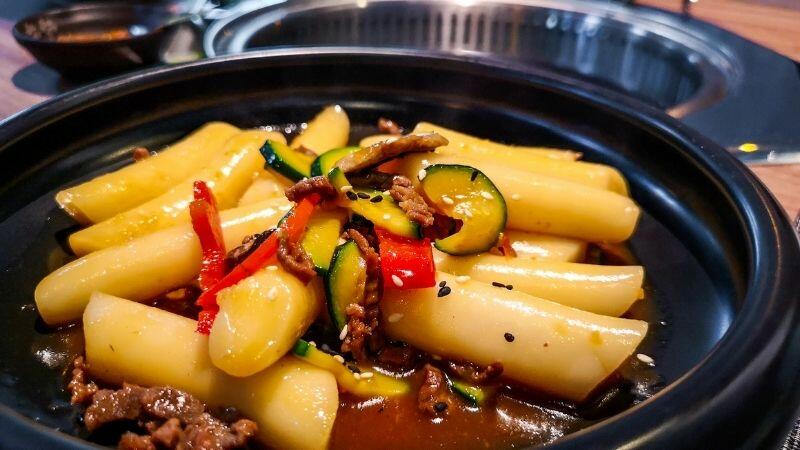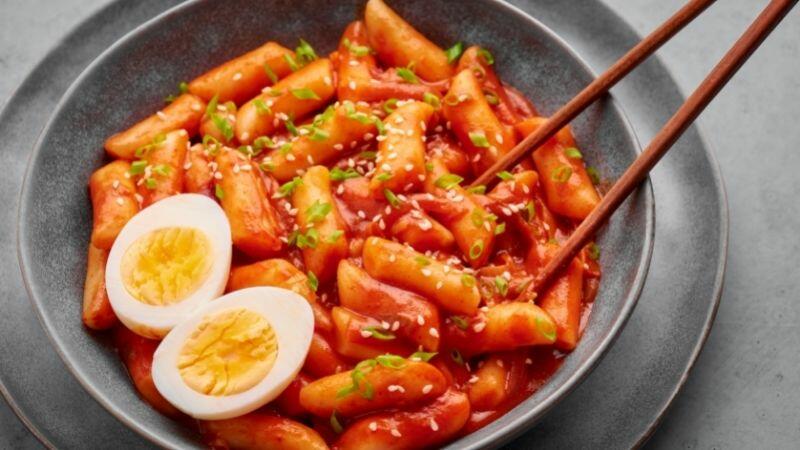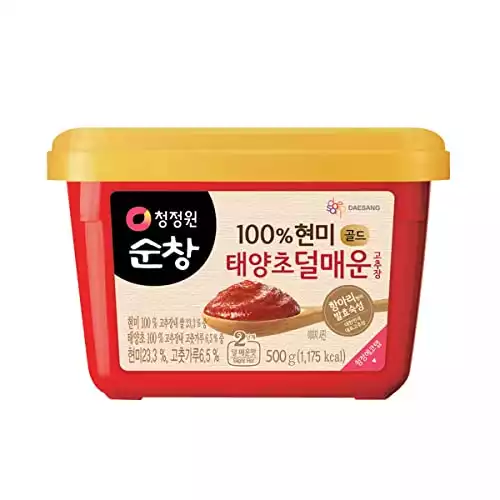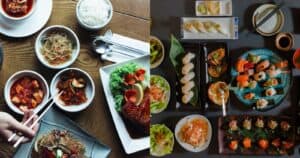Have you ever wanted to try the popular Korean rice cake dish tteokbokki but were put off by how incredibly spicy it usually is? You’re not alone! While traditional tteokbokki recipes call for gochujang (Korean red chili paste) to give it that signature kick, there are ways to tone down the heat and make a milder version that anyone can enjoy.
In this comprehensive guide, you’ll learn everything you need to know to make a non-spicy tteokbokki that doesn’t sacrifice any of the delicious flavors. We’ll cover:
- What exactly is tteokbokki and why is it so popular
- Tips for buying and preparing the main ingredients
- How to make authentic tteokbokki broth
- Ideas for toning down the spiciness
- Alternative seasonings to use instead of gochujang
- Vegetable and protein add-ins that complement tteokbokki
- Step-by-step instructions for making mild tteokbokki
- Serving ideas and garnishes
So get ready to become a tteokbokki master – minus the blow-your-head-off spiciness!
What Is Tteokbokki?

Tteokbokki (pronounced “tock-bok-ee”) is a classic Korean street food consisting of chewy cylinder-shaped rice cakes simmered in a sweet and spicy red chili sauce. It’s commonly topped with fish cakes, boiled eggs, and green onions.
The name “tteokbokki” comes from the Korean words “tteok” meaning rice cake and “bokki” meaning stir-fry. The rice cakes are made from rice flour and have a texture similar to gnocchi or short pasta shapes.
Tteokbokki was originally created in the middle of the 20th century when street vendors in Seoul began selling it from food carts as a quick, hot snack. Its popularity boomed and it became a Korean food staple.
What makes tteokbokki so addictive is the contrast of the soft, chewy rice cakes and the sweet heat of the spicy gochujang sauce. The sauce clings nicely to each little rice cake, allowing you to experience flavors of sweet, salty, spicy, and umami in each bite.
So while traditional tteokbokki is a savory, fiery dish, there are easy ways to tone down the heat to make a milder, family-friendly version that anyone can enjoy.
Tips for Buying Ingredients
To make great tteokbokki, you need just a few main ingredients:
Rice Cakes
The most important component is the cylinder-shaped rice cakes, called tteok in Korean.
For mild tteokbokki, use the plain white rice cakes, not the rainbow colored ones which will bleed and look unappetizing.
Look for rice cakes that are about an inch long. You can find them in the refrigerated or frozen section of any Asian supermarket.
Gochujang (Red Chili Paste)
This Korean red chili paste is what gives traditional tteokbokki its signature kick. It’s made from fermented soybeans, rice, and chilies.
For a mild version, use less gochujang or omit it completely and use another sauce.
Mild Hot Sauce, Spicy, Sweet and Savory Korean Traditional Fermented Condiment, Brown Rice, 1.1lb
Stock
Tteokbokki is simmered in an umami-rich broth. Beef or anchovy stock yields the best flavor.
You can use store-bought stock or make your own. Optional ingredients like kelp and dried shiitake mushrooms add even more savory depth.
How to Make Tteokbokki Broth
To build a flavorful foundation for your tteokbokki, start by making a homemade broth.
The broth only requires 4 ingredients:
- 6 cups water
- 1 cup beef or anchovy stock
- 3 dried kelp strips
- 5 dried shiitake mushrooms
Bring the water to a boil in a medium pot. Add the stock, kelp, and mushrooms. Reduce heat and simmer for 20 minutes.
Strain the broth through a mesh strainer. Pick out any debris.
You’ll be left with a deeply savory dashi broth ready to simmer your rice cakes in.
Toning Down the Spiciness
There are a few easy ways to temper the heat and make a milder tteokbokki:
- Use less gochujang – Start with only 1-2 tablespoons and add more to taste
- Substitute gochugaru (Korean red pepper flakes) for some of the gochujang – It adds mild heat without overwhelming
spice - Add a touch of sugar – A teaspoon of sugar balances out spiciness
- Use milk instead of water – Milk helps tame spiciness and gives a creamy texture
- Limit other spices like garlic and ginger – Stick to small amounts to prevent overpowering flavors
- Add cheese – Melting cheese into the sauce creates a buffer against the
spice
The key is adding the spicy components gradually and tasting until you reach desired mildness.
Alternative Seasonings
For a tteokbokki with no spiciness at all, you can omit the gochujang completely and use other sauces instead:
- Soy sauce – For a classic salty flavor
- Oyster sauce – Adds savory umami notes
- Hoisin sauce – Imparts sweetness
- Tomato sauce – Gives tangy brightness
- Curry powder – Infuses an earthy aroma
- Gochujang powder – Provides only mild spiciness
Mix and match different sauces to create your own signature tteokbokki flavor.
Using soy sauce or oyster sauce instead of gochujang will reduce the overall spiciness of the dish. The salty umami flavor of these sauces complements the rice cakes nicely without overpowering heat.
To make up for the missing
- Garlic
- Green onions
Adding extra garlic and green onions boosts the flavor so your mild tteokbokki still tastes delicious. Their aromatic presence balances out the reduced spiciness.
Vegetable and Protein Add-Ins
One of the best things about tteokbokki is how easily you can customize it by mixing in delicious add-ins.
Popular mix-ins include:
- Eggs – Hard boiled or scrambled
- Fish cakes – Contrasting texture
- Onions – For crunch and aroma
- Carrots – For sweetness
- Mushrooms – Meaty, umami flavor
- Tofu – For protein
- Kimchi – For a touch of fermented tang
Get creative and add any vegetables, proteins, or toppings you enjoy!
Step-by-Step Mild Tteokbokki Recipe
Now that you’re armed with all the knowledge to make tteokbokki that isn’t spicy, try this easy recipe!
Ingredients:
- 1 pound tteok (rice cakes)
- 3 cups dashi broth
- 3 tablespoons soy sauce
- 1 tablespoon oyster sauce
- 1 tablespoon brown sugar
- 1 cup mixed diced veggies (onion, zucchini, carrot)
- 4 ounces fish cakes, sliced
- 2 eggs, hard boiled and sliced
- 1 green onion, sliced
Instructions:
- Rinse the tteok under cold water to separate. Drain well.
- Add dashi broth, soy sauce, oyster sauce, and brown sugar to a skillet. Bring to a boil.
- Add tteok and fish cakes. Reduce heat to low and simmer for 5 minutes.
- Mix in vegetables and cook 3 more minutes until heated through.
- Transfer tteokbokki to bowls. Top with egg slices and green onions.
That’s it! Now you can enjoy mild, family-friendly tteokbokki that isn’t spicy. Customize it to your tastes by using different vegetables, proteins, or sauces.
Serving Suggestions
Tteokbokki is usually served hot and steaming right out of the pan. But here are some other fun ways to eat it:
- Sandwich it in a hoagie roll for easy eating
- Stuff it into tacos for a Korean-Mexican mashup
- Serve it over rice like bibimbap
- Top it with mozzarella for impromptu tteokbokki pizza
- Wrap in lettuce leaves and make tteokbokki wraps
- Mix it with noodles for japchae tteokbokki
However you choose to serve it, non-spicy tteokbokki makes for a quick, comforting meal the whole family can enjoy together. Give this classic Korean street food a try with a mild twist!
What If My Tteokbokki is Already Made and Too Spicy? How Can I Tone it Down?
Oh no, your tteokbokki turned out extra fiery and spicy! Don’t worry, you can still tone down the heat even after it’s finished cooking.
If your tteokbokki is already plated and spicier than you hoped for, try these easy fixes:
- Add a dollop of plain yogurt or sour cream. Dairy helps balance out chili heat.
- Mix in a spoonful of honey. Sweetness helps counteract spicy chili flavors.
- Stir in some cooked white rice. The rice absorbs some of the excess
spice . - Sprinkle on extra green onions. They add a cooling, crisp contrast.
- Drizzle a little sesame oil over the top. Its nutty taste helps mellow the burn.
- Squeeze fresh lemon or lime juice over it. Acidity helps cut through the chili.
- Top with sliced avocado. Creamy avocado provides cooling relief.
With just a few extra toppings and condiments, you can tame down tteokbokki that accidentally ended up too fiery and spicy when already finished. Now you can enjoy the full flavor without the painful heat!






